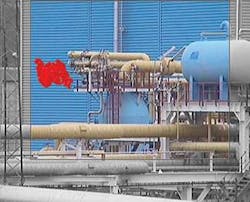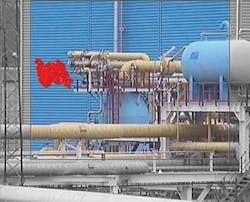GAS DETECTION: Novel gas leak detection technique to monitor Kårstø process operations
Statoil has contracted GasOptics for a Gas Vision System (GVS) for the Kårstø gas processing plant in western Norway. This is GasOptics first full-scale order for this technology, which is designed to make gas leak detection more efficient, and to help minimize unintended emissions. The order was placed following an extensive one-year testing program.
According to GasOptics CEO Stefan Nilsson, the Kårstø order will involve six GVS cameras, with delivery scheduled to be completed by next March. The cameras will be installed in areas where gas is processed and at loading areas. A pilot operation was performed at the plant during 2004-05.
Statoil is not only a customer, but also GasOptics’ major owner. In 2003, it took a 70% stake through Statoil Innovation, its vehicle for supporting start-up companies. Since then GasOptics has carried out several joint projects with potential customers within the group aside from Kårstø, according to founder Jonas Sandsten.
The GVS system is a completely new method of sensing gas, using infrared detection modules sensitive in gas’ spectral region. Gas clouds can be detected by monitoring the thermal radiation that arises from a temperature difference between the gas and the background.
The infrared detectors were originally developed for military applications, and have since been further refined for gas detection. The company has so far concentrated on methane detection, but the system can also be optimized for other gases.
Thermal radiation emitted or absorbed by the gas and detected by the camera is processed into a visual image of the gas. This is color-coded - typically in shades of red - to represent the strength of concentration. The picture is overlaid on an image of the location recorded by a normal camera. In this way the gas - normally invisible - appears as a cloud, and the source of the leak in the piping is easy to identify. Video clips can also be recorded, if required.
The system can be used in automatic mode, checking pre-selected locations at set intervals, or manually controlled by the operator.
For Kårstø, GasOptics is supplying the long-range GVS version, fitted with a telescope. The cameras, which are about one meter long and weigh about 30 kg, will each be mounted on a pan/tilt device enabling them to turn through 360°. They can detect gas in a range of 10-250 m. At 150 m the spatial resolution allows a one-meter gas cloud to be detected, Sandsten says. The cameras have Atex and UL certification for use in hazardous areas.
The system made an immediate impression during the Kårstø pilot, Sandsten recalls. It identified a critical leak in a newly installed dew point control unit which was too distant for other detectors to sense. In the process, the system saved seven times its own cost.
Offshore applications
GasOptics is now developing a wide-angle camera, which will be suitable for use on offshore installations. This is a fixed device with a detection range of 50-100 m. Another planned development is a portable system with a similar range. This is intended for enclosed spaces such as tubes or buildings, and also for monitoring pipelines from a helicopter.
GVS presents clear benefits over alternative detection systems. While a single long-range GVS camera can cover the whole surrounding area within a radius of 250 m, a point detection system requires a point detector every 5 m through which air can be sucked in and sampled for gas. Line detectors based on laser beams, generated between fixed points, can probe long distances, but can only detect gas if it crosses the beam. Neither of these systems can match GVS in terms of showing the gas cloud emanating from a leak, its concentration and how it develops and spreads in real time.
Sleipner pilot
In October the company is due to make its first offshore installation for a pilot project on Statoil’s Sleipner field. Another pilot is to get under way this autumn at a gas plant in Scotland.
Last year a GasOptics team visited several Latin American countries to demonstrate the system, and enquiries have also come in from around the US, Kazakhstan and Malaysia. Recently, the company appointed a sales manager in Stavanger to market the technology more actively.
Investment manager Solveig Holter at Statoil Innovation is pleased that GasOptics’ technology is fulfilling its potential. “We see GVS as the next generation of gas detector,” she says. “For Statoil it is interesting both for environmental and safety reasons, and it can be used both onshore and offshore. Having first developed the long-range camera, GasOptics is now working on a wide-angle version for offshore.”
For more information contact Stefan Nilsson or Jonas Sandsten, GasOptics Sweden. Tel +46 46 286 5390, fax +46 46 286 5399,[email protected], [email protected].

